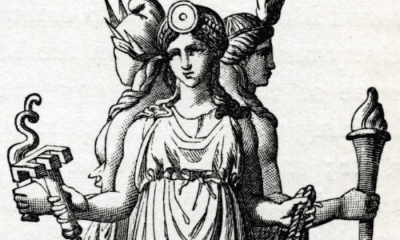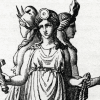
Greek
Zeus and Semele
Zeus and Semele
Dionysus is one of the chief gods of Olympus, but how much do you know about his parents? The story of Zeus and Semele is one of the most tragic in Greek mythology!
Semele’s story started out similarly to that of any other beautiful princess in Greek mythology. Spotted by Zeus, the amorous king of the gods made her his mistress.
Like many of her peers, Semele and her pregnancy were eventually discovered by Hera. Zeus’s jealous wife devised a scheme that would end in Semele’s death at Zeus’s hand.
Zeus was able to save her child, though, and carried the baby in his own thigh until he was ready to be born. Dionysus was born for a second time and welcomed into the pantheon.
The story of Semele is a sad one, but one that the Greeks later reinvented. Through both the unusual beliefs of the mystery cults and a progressively more optimistic view of the afterlife, Semele was given both more authority in her story and the chance to join her grown son on Olympus.
The Tragic Story of Semele
Semele was a Phoenician princess and one of the many mortal lovers of Zeus.
Her own mother was a goddess. Harmonia, the daughter of Aphrodite and Ares, had married the human king Cadmus.
Cadmus was a great hero whose deeds had made him worthy of the hand of a goddess. Together, the couple founded the city of Thebes.
Semele is most often said to have been a priestess in the temple of Zeus in her father’s city. After slaughtering a bull as a sacrifice, she was seen by Zeus as she bathed in the river to wash the animal’s blood off of herself.
Zeus was immediately smitten with the young priestess and flew over her many times as an eagle to see her. Eventually, he made her his mistress and visited her often.
Hera, who was constantly jealous of her husband’s infidelities, found out about his Theban consort and sought revenge against the girl. She was even more enraged when she learned that Semele was carrying her husband’s child.
Rather than resort to violence, however, the goddess used trickery to punish the girl.
Hera disguised herself as an old woman and went to Thebes. Outside of her husband’s temple, she befriended the human girl and soon became one of her closest confidants.
When talking about her pregnancy, Semele admitted to the old woman that the baby’s father was the king of the gods. Hera feigned disbelief and asked the girl how she could be sure it was Zeus and not a lesser god trying to trick her.
Semele had never doubted Zeus before, but Hera’s words made her uncertain. The next time she saw Zeus, she decided to find out the truth.
Semele coyly asked the god if he would grant her a favor. He agreed and even swore a sacred oath on the River Styx that he would do anything she asked of him.
When he agreed, Semele asked him to prove his identity by revealing himself to her in his full glory.
Zeus tried to dissuade her, but Semele was adamant. Bound by a sacred oath, the king of the gods had no choice but to grant her request.
Zeus tried to reveal the smallest possible amount of his power to Semele, but even that was too much. No human can survive being confronted with the full majesty of a god and Semele was instantly incinerated by Zeus’s own thunderbolts.
The girl was dead, but Zeus was able to save the child she carried. He quickly took the fetal child and sewed him into his own thigh until it was time for his birth.
After a few months, Zeus opened his leg and gave birth to Dionysus. The god of wine was sometimes referred to as the twice-born for having been taken from his mother’s body and put into his father’s until he reached full term.
My Modern Interpretation
The story of Zeus and Semele was one of the more tragic of Zeus’s human lovers, but over time Semele became a more triumphant figure.
The first major change to Semele’s character came in the form of the Orphic mystery cults. The cults often had different versions of major myths than the mainstream religion, with a focus on learning the secrets of death.
The mystery cults believed that Semele was not the first mother of Dionysus.
According to their stories, Zeus had seduced Persephone in the form of a snake and she had given birth to a son. The child god was so adored by his father that Zeus allowed the boy to sit on his throne and wield his thunderbolts.
Hera and the Titans were jealous of the child and cut him to pieces. All Athena was able to recover for her father was the boy’s heart.
According to the Orphic tradition, Zeus made the heart of his son into a potion which he gave to Semele to drink. As a result she became pregnant with Dionysus, the reincarnation of Persephone’s murdered child.
Semele was still killed, but this time out of a desire to interrupt the resurrection rather than because of her own relationship with Zeus.
This story separates Semele from the usual archetype of Zeus’s young mistresses. Instead, she became a priestess that worked with her god to allow the rebirth of a beloved god.
The Orphic mysteries may have been influenced by the Egyptian myth of Osirus. Their beliefs made Dionysus not just the god of wine, but a being that had successfully passed into the land of the dead and been reborn.
The beliefs of the Orphic cultists were not widespread in the ancient world, however. Only those who were initiated into the mystery rites would have access to this alternative story of Semele and her son.
In the Hellenistic period, however, a more mainstream belief would see Semele get a happier ending.
Throughout most of Greek history, the underworld had been considered to be a universally dismal place. Over time, however, the Greeks began to believe that those who lived exceptionally good lives would be rewarded with a more pleasant experience.
At the same time, they began to imagine that some of their most popular heroes had been given a better ending as well. For the sons and daughters of the gods, they began to think it was possible for the best among them to have been taken to Olympus and made gods themselves.
Many figures from earlier stories were thus given new endings in which they joined their loved ones as immortal Olympians. One of these was Semele.
While Heracles was allowed to ascend directly after his death, however, Semele had been taken to the underworld as a mortal. Her son Dionysus went to the realm of Hades himself to bring her out and take her to his home among the gods.
Semele was reborn as Thyone, the goddess of her son’s frenzied followers. After thousands of years, Greek mythology had progressed toward a more positive outlook and Zeus’s former mistress was able to spend the rest of time in the company of the son she had never been able to meet.
In Summary
Semele, the daughter of Harmonia and Cadmus, was a priestess of Zeus in Thebes. When he saw her bathing the god fell in love with her and made her his mistress.
When Hera learned that the Theban priestess was carrying Zeus’s baby, she came up with a scheme to destroy both mother and child. Planting seeds of doubt in the girl’s mind, she convinced Semele to see Zeus in his full divine glory.
Although Zeus tried to spare her, he was not able to conceal his nature enough to keep Semele safe. The girl was burned in an instant, unable as a mortal to withstand seeing the full majesty of a god.
Zeus was able to save his unborn son, though. Sewing the baby into his own thigh until it came to term, he eventually brought Dionysus out of his own body safely.
Semele’s story was a tragic one, but the ever-evolving nature of Greek belief gave the character an opportunity for a happy ending.
The Orphic cults believed that Dionysus was the reincarnation of a previous child of Zeus who had died as a result of Hera’s schemes. Rather than being another in a long line of mistresses, Semele was to them an active participant in the resurrection of a major god.
Later still, new views of the afterlife led to a proliferation of characters who were made immortal after their deaths. Semele became one of these demi-gods when her son went to the underworld himself to bring her out and take her to his home among the gods.



